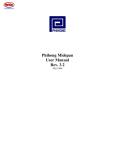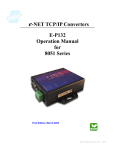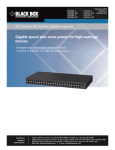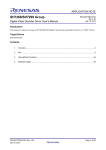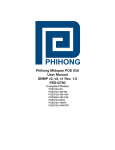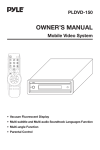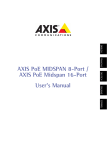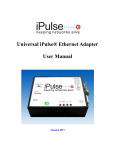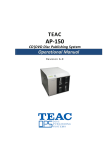Download 24-Port Gigabit PoE Mid Span User Manual Rev
Transcript
P7024A / P7124A (With SNMP) 24-Port Gigabit PoE Mid Span User Manual Rev. 1.0 Disclaimer Alpha Telecom, Inc. USA accepts no accountability or liability arising from the use of the Midspans, as described in this document. The handling of equipment will be users’ responsibility. Applications described in this document are for descriptive purposes only. ATIU does not provide warranty for modified products. Notice This document contains informative information about the software and hardware used on the P7024A Midspan. The information is held to be accurate and reliable from time of print. Please be advised that product development and revisions are still in course of action. ATIU cannot be held responsible for involuntary error, exclusions, inaccuracies, or following changes of printed material. ATIU reserves the right to make changes to products and to their specifications as described in this document, at any time, without prior notice. The contents of this document may not be photocopied or reproduced in any form without written permission of ATIU. NOTE: Midspans are for indoor use only! © January 2007 Alpha Telecom, Inc. U.S.A. All Rights Reserved. This document is subject to change without notice. 2 Contents 1. Safety Procedures 1.1 2. General Precautions ……………………………………………………. 4-6 Midspan Hardware Setup 2.1. Physical Hardware Appearance ….…………………………………….. 7 2.2. Power Cord Requirements ……………………………………………… 8 2.3. Connecting Ethernet Cables …………………………………………….. 9 2.4. Connecting USB and Power Cables …………………………………….. 9 2.5. Powering Up …………………………………………………………….. 10 2.6. LED Indicators ……….…………………………………………………. 10-11 2.7. Rack-Mounting Installation ……………………………………………... 11 2.8. Technical Specifications ………………………………………………… 12-13 3. 4. Phihong GUI and USB Driver Installation 3.1 PC-to-Midspan Connection via USB/RS232………………………….... 14 3.2 Device Manager: To View Port Properties ………………………………15-16 3.3 USB block diagram ……………………………………………………... 17 P7024A GUI 4.1 GUI Main Window …………………….………………………………. 18-19 4.2 GUI System Control ……………………………………………….…... 20 4.3 GUI System Information ………………………………………………. 21-22 4.4 GUI Port Description ……………………………………………….……23-24 4.5 GUI Parametric Information ……………………………………………. 25 5. Troubleshooting ………………………………………………………………...…. 26 6. Appendix A. Optional RPS – option R ...……………………………………………… 27-28 B. Optional NIC Interface - option N ……………………………………... 29-52 C. Frequent Questions ……………………………………………………… 53 3 Disclaimer Alpha Telecom, Inc. USA accepts no accountability or liability arising from the use of the Midspans, as described in this document. The handling of equipment will be users’ responsibility. Applications described in this document are for descriptive purposes only. ATIU does not provide warranty for modified products. Notice This document contains informative information about the software and hardware used on the P7024A Midspan. The information is held to be accurate and reliable from time of print. Please be advised that product development and revisions are still in course of action. ATIU cannot be held responsible for involuntary error, exclusions, inaccuracies, or following changes of printed material. ATIU reserves the right to make changes to products and to their specifications as described in this document, at any time, without prior notice. The contents of this document may not be photocopied or reproduced in any form without written permission of ATIU. NOTE: Midspans are for indoor use only! © April 2007 Alpha Telecom, Inc. U.S.A. All Rights Reserved. This document is subject to change without notice. 4 List of Figures: Figure 1 - P7024A is not connected ………………….…………………...……..…….. 7 Figure 2 - Data & Power (top row), Data (bottom row) ………………………………… 7 Figure 3 - Connectors and Indicator …………………………………………………….. 7 Figure 4 - Rear Side of P7024A ……….…………………..……………………...…….. 7 Figure 5 - DC Power Connector ………………………………………………………… 7 Figure 6 - AC Power connector …………………………………………………………. 7 Figure 7 - P7024A connected through ‘Data & Power’ line ………………….………..... 9 Figure 8 - NIC Cable …………………………………………………………………….. 9 Figure 9 - USB Cable ……………………………………………………………………. 9 Figure 10 - USB Cable Connected ………………………………………………………. 9 Figure 11 - AC Power Cord ……………………………………………………………… 9 Figure 12 – Rack-Mounted Midspan …………………………………………………….. 11 Figure 13 – Rack mounting bracket and screws …………………………………………. 11 Figure 14 - GUI Main Window ……..…………………………………………………… 17 Figure 15 - System Setup & Control …………………………………………………….. 18 Figure 16 - System Information and Port Commands …….………………………………19 Figure 17 - Port Description ……………………………………………………………… 20 Figure 18 - LED Key (Port Status)………………………………………………………... 21 Figure 19 – Port Specific Control ………………………………………………………... 22 Figure 20 Parametric Information ……………………………..…………………………. 24 List of Tables: Table 1: LED Indicator ………………………………………………………………….. 11 Table 2: Electrical Specifications ……………………………………………………….. 13 Table 3: Troubleshooting ………………………………………………………………... 35 5 1.1 Safety Procedures – General Precautions General - Please read the following precautions carefully before installing and connecting the system to a power source. Note – Only qualified and trained service personnel (in accordance with IEC 60950 and AS/NZS 3260) should install, replace, or service the equipment. Install the system in accordance with Country, National or to the U.S. National Electric Code if you are in the United States. Precautions: 1. The building facilities in which the product will be used requires a fuse or circuit breaker no larger than 15 A for 120 Vac (U.S.A.) or 10 A, 230 Vac (international). The building facilities must protect the PoE370U Midspan from over current or short-circuits. 2. Before connecting the P7024A Midspan to a power source (including power cord requirements), read the Midspan Hardware Setup procedure in Section 2. This procedure as with all procedures and instruction s can be found in the P7024A Midspan User Manual. 3. To prevent the P7024A Midspan from overheating, do not operate the product in an area that exceeds the maximum recommended ambient temperature of 40 ºC. Allow at least 3 to 4 inches of clearance around all ventilation openings. 4. In order to support the P7024A Midspan weight, do not stack the chassis on any other equipment. Shelf mounted equipment requires a stable and durable surface. When installed, do not push or pull on the Midspan when the equipment is installed. 5. The P7024A Midspan consists of two rows of “Data and “Data & Power” ports. The ports use RJ-45 data sockets. Do not connect telephone cables into these ports. Only RJ45 data cables may be connected to these sockets. 6. Do not work on the P7024A Midspan system or connect or disconnect cables, during periods of lightning activity. 7. The AC or DC plug/socket combination must be accessible at all times, as it serves as the main disconnect device to the product. 8. Before servicing the product, always disconnect the product from its AC and DC source. 9. Disposal of this product should abide by all appropriate National laws and regulations. 6 2. 2.1 Midspan Hardware Setup Physical Hardware Appearance: Front Side of P7024A Midspan: Fig. 1 P7024A is not connected AC LED USB Connector Fig. 2 Data & Power (top row), Data (bottom row) Fig. 3 Connectors and Indicator Rear Side of P7024A Midspan: Fig. 4 Rear Side of P7024A Fig. 5 AC Power Connector AC in – IEC320 inlet 3 pin 7 2.2 Power Cord Requirements: Power cords must meet the requirements for the country it is intended to be used. U.S.A. and Canada • • • • Europe The cord must have a minimum of 10A rated current competence. The cord must be CSA or UL approved. The minimum requirement for the flexible cord is: o 18 AWG (10A) o Three-conductor (Line, Neutral, Ground) o Type SV (Stranded Vacuum Rubber Jacketed) or SJ (Stranded Junior Rubber Jacketed) or SVT (Stranded Vacuum Rubber Jacketed Themoplastic) or SJT (Stranded Junior Themoplastic) The plug must be earth-grounded with a NEMA 5-15P (15A, 125 V) or NEMA 6-15P (15A, 250 V) configuration. Switzerland • The supply plug must comply with SEV/ASE 1011. Denmark • The supply plug must comply with section 107-2-D1, standard DK2-1a or DK2-5a. United Kingdom • The Midspan is covered by General Approval (section 16.16.060), NS/G/12345/J100003, for indirect connection to a public telecommunication system. France and Peru • IT equipments cannot power this device. In the case of an IT powered device, the unit needs to be powered by 230 V through an isolation transformer with a ratio of 1:1 and the secondary connection (Neutral) is properly grounded. The Midspan must have access to a nearby power outlet. By disconnecting the power cord from the outlet, you will eliminate power from the device. The flexible cord that connects to the Midspan must have a configuration to connect with an EN60320/IEC320 inlet connector. According to the EN60950/IEC 950 specifications, this device functions under SELV (Safety Extra Low Voltage) conditions. The conditions are true if the equipment and the connected device functions under SELV conditions. 8 2.3 Connecting Ethernet Cables* Fig. 6 P7024A connected through ‘Data & Power’ line 2.4 Connecting USB and Power Cables USB cable: The USB cable is connected to the USB connector located in the front side of the P7024A and a USB port on your PC/labtop. Fig. 7 USB Cable* Fig. 8 USB Cable Connected AC power cord: The AC power cable is connected to the AC power connector located in the rear side of the P7024A and the power outlet. Fig. 9 AC Power Cord** *Ethernet and USB cables are not included ** AC Power Cord may be order separately 9 2.5 Powering Up P7024A Midspan is powered by the power cord. In order to apply or remove power to/from the Midspan, connect or disconnect the AC power cable to/from the AC power connector on the rear side of the unit. With AC power applied, the unit starts-up and the internal fans are active. The device runs through a quick power-on test, which takes less than 10 seconds. During this period, all ports are initially disabled and the port indicators light up. The sequence of the port LEDs are shown in section 2.6 LED Indicator – Cold Start. Ports are now operating under normal conditions. 2.6 LED Indicator: Cold Start: a. AC – LED turns ‘green’ Æ remains on b. NIC – LED turns ‘green’ Æ red Æ green Æ turns off Æ red Æ turns off (unless connected) c. 24-Ports (with ports connected) – LED turns ‘orange’ Æ green Æ orange Æ green Æ turns off – LED turns ‘green’ individually Æ ports 1,9,17 Æ ports 2,10,18 Æ ports 3,11,19 Æ ports 4,12,20 Æ ports 5,13,21 Æ ports 6,14,22 Æ ports 7,15,23 Æ ports 8,16,24 Æ All 24-Ports are connected – LED remains ‘green’ d. 24-Ports (without ports connected) – LED turns ‘orange’ Æ green Æ orange Æ green Æ turns off – LED blinks ‘orange’ individually Æ ports 1,9,17 Æ ports 2,10,18 Æ ports 3,11,19 Æ ports 4,12,20 Æ group 5,13,21 Æ ports 6,14,22 Æ ports 7,15,23 Æ ports 8,16,24 Æ Blinks ‘orange’ across all 24-Ports When ‘System Reset’ is clicked on the GUI (application file): a. AC – LED remains ‘green’ b. NIC – LED remains off unit connected c. 24-Ports (with ports connected) – same sequence as Cold Start d. 24-Ports (without ports connected) – same sequence as Cold Start 10 Indicator 24-Port LED LED Off Indicates port is disabled NIC LED Indicates NIC is disconnected from Network Indicates Midspan is not powered AC LED 2.7 Table 1: LED Indicator Conditions Green Orange Indicates port is Indicates port has connected an error Blinking Orange Indicates port is disconnected but enabled N/A Indicates NIC is connected to Network N/A Indicates Midspan is powered N/A N/A Rack-Mounting Installation Fig. 10 Rack-Mounted Midspan (front) Fig. 11 Rack mounting bracket and screws (side/rear) Position the Midspan on the rack. Arrange the mounting bracket to the corresponding screw holes on the Midspan. Keep the screw area visible to insert screws, and then tighten the screws. Screws and brackets will be included in the package. 11 2.8 Technical Specifications Mechanical Specifications: Dimensions – 17.25 inch (438 mm) length 8.98 inch (228 mm) width 1.75 inch (44.5 mm) height Environmental Specifications: Temperature - Operating: 0°C to +40°C - Non-Operating: -25°C to +65°C Relative Humidity - Operating: 5% to 90% - Non-Operating: 5% to 90% 12 Electrical Specifications: Table 2: Electrical Specifications Parameters Specifications AC Input voltage rating AC Input voltage range AC Input current AC Input frequency: 100VAC to 240VAC 90VAC to 264VAC 5.5A (rms) at Max. load 47Hz to 63Hz Max. In-rush current 30A for 115VAC at Max. load 60A for 230VAC at Max. load DC Input voltage range 47VDC to 57VDC (-R option) DC Input current 8.7A max AC Output voltage Max. load current Output Power, per port Total Output Power -480 50VDC 56VDC 0.32A 0.275A 15.4W (not to exceed total output power) -8 125W max Nominal Output Voltage -560 No. of ports -16 250W max 44VDC to 57VDC 13 -24 370W max 3. ATIU GUI and USB Driver Installation: Please follow the Installation Wizard to install the ATIU GUI and the USB-to-Serial Comm Port driver. The USB-to-Serial Comm Port driver is necessary for communicating between the Midspan via a Communication Port on the PC. Note: Please refer to the ATIU website to insure you are installing the latest version of the ATIU GUI. 3.1 PC-to-Midspan Connection via USB/RS232 14 3.2 Device Manager: To view Port Properties When you are ready to begin, please connect the proper end of the USB-to-Serial cable to your P7024A Midspan and the other to an avai lable USB port on your PC. If you installed the USB driver described above, your PC will locate the new hardware. To view which Serial COM Port your P7024A Midspan is installed, please follow the instructions: Æ Please click Æ Æ , the following window will open: Locate and expand ‘Ports (COM & LPT)’ 15 Double click . In this example, the USB-to-Serial Comm Port is installed on COM1. The COM Port will vary upon user. Click . Assure Port Settings is as shown. Click menu to select the COM Port Number or stay with default. . Click the pull down Æ Click to save all changes. Note: The P7024A GUI only supports COM1 to COM16. 16 3.3 USB block diagram USB port (PC) USB Device (Midspan) Internal function The PC automatically detects the newly installed hardware. This function is called Plug&Play, available with a USB connection. Connects USB Port (PC) to device (Midspan) via USB cable. Internal USB device (Midspan) sends a signal to your PC, creating a “Virtual COM Port.” A Virtual COM Port corresponds to a serial communication port. The PC quickly identifies the connection as Serial Com. Windows will automatically install your device on an available serial COM port. Changes may be made via Device Manager. Section 3.2 discusses Device Manager. Wait for PC to respond. Note: Assume USB-to-Serial-Comm Port driver is installed. Users’ PC will automatically detect the newly installed/connected hardware. 17 4. P7024A GUI The firmware is supplied with a Graphical User Interface (GUI), which is used to configure and manage the PoE midspan system. If you have successfully installed the Phihong GUI and USB driver – Please locate the Alpha Telecom P7024A GUI on your desktop or from your Start menu. Step 1: Choose Connection Type: Step 2: Select Auto Scan: If ATIU P7024A Device is found, click Linking. 18 4.1 GUI Main Window: Figure 12: GUI Main Window Note: All features except for the Download and Comm Port commands are supported for the Optional NIC Interface – option N found in Appendix B. 19 4.2 GUI System Control: The System Control panel on the GUI supports the main system level parameters for the µP. Figure 15: System Setup & Control The system level parameters that can be configured are: • System Reset – This is a function that allows the GUI to reset the software on the µP. (If System Reset is set and the GUI does not respond, user must click “Reset GUI”) • Reset GUI – This resets the GUI. • Ports in System – This automatically selects the number of ports in the system. • The “Update System” button will send all configuration information for both system level and port level parameters to the µP. 20 4.3 GUI System Information: The System Information panel on the GUI displays information about the PoE ID, firmware revision, and system status. Figure 13: System Information and Port Commands Note: Please allow the GUI a few seconds to respond to the commands selected. DO NOT click or check any commands simultaneously. If a command is selected more than once within two seconds, the GUI may not respond properly. If the GUI fails to respond, wait five seconds and then click “Reset GUI” (click “Reset GUI” again if necessary). Verify that the “System Status” reads “0”, which indicates that there is a good connection. The “Save Parameters to Flash” button will save system and port parameters to flash memory, so that they can be used by the firmware across reboots of the µP. The “Restore Factory Defaults” button will reset the defaults in the firmware, and clear any stored data in the flash memory, the device will reset automatically. After the device has successfully reset, the “System Status” will read “0.” Click “Reset GUI” if necessary. To make the factory defaults permanent, the user must click “Save Parameters to Flash.” The PoE ID field specifies the hardware revision of the PoE device. The firmware version is represented in a major.minor format. If “System Status” reads “0” it means that the system and the GUI are communicating. If “System Status” reads “No Connection” it means that the system is not communicating with the GUI and the user needs to “Reset GUI.” System ID/Name - click “Edit” to edit/change the description of the system. If you click “Cancel”, the previous description will be set for the system. To make this permanent, the user must click “Save Parameters to Flash.” 21 The “Download” or “ENTR” feature is used to download new application/firmware code onto the µP. Please refer to the ATIU website (www.alpha-tele.com) or email to [email protected] for.the test firmware – POE Firmware During the ‘Download In Progress’, the GUI function buttons will be temporarily disabled. Example file: 22 4.4 GUI Port Description: The Port Description panel shows 24-ports. On the PoE midspans that have 8 or 16-ports, the port number higher than the system port count will be shaded grey and disabled. Each section specifies the individual port descriptions for the system. Figure 14: Port Description Changes to the port configuration in this section can be enacted when the user clicks the “Send Port Control” button. It will send the port information to the µP for 24-ports. Please allow the GUI 10 seconds to refresh when action is taken. Port Description – Click “Edit” to edit/change the description of the port. Click “Ok” to set description on the GUI screen. If you click “Cancel”, the previous description will be set for that particular port. Click “Send Port Control” to send the descriptions to the system. To make this permanent, the user must click “Save Parameters to Flash.” Enable – This check box can administratively enable or disable the selected port. If “Enable/Disable All Port” checkbox is selected, all ports will be enabled. Initially, the checkbox is not checked, but by default all ports are enabled. Click “Send Port Control” to send the command to the system. To make this permanent, the user must click “Save Parameters to Flash.” If “Detect Legacy Signature” checkbox is selected, all ports are enabled and the firmware will try to detect legacy devices. By default, legacy detection is disabled. The message in blue states that the “Legacy Detect is Enabled” (Figure 14). Click “Send Port Control” to send the command to the system. To make this permanent, the user must click “Save Parameters to Flash.” 23 The different colored LEDs show the status of the individual ports. ‘Yellow’ LED shows the port is detecting or ready to be connected. ‘Red’ LED shows the port as Disable/Error. ‘Green’ LED shows that the port is connected. Figure 15: LED Key (Port Status) 24 4.5 GUI Parametric Information: This section allows users to review, but not edit, the Parametric Information for each port. Figure 16: Parametric Information The Port Parametric Information panel has the following set of parameters that are displayed: • Discovery R (ohms) – This value represents the discovered resistance (R) of the port in ohms. • Current (mA) – This value represents the current (I) of the port in milliamps. • Voltage (V) – This value represents the voltage (V) of the port. • Power (mW) – This value represents the power of the port in milliwatts. • Class Current (mA) – This value represents the class current of the port in milliamps. • Determined Class – This value represents the class of the discovered device. Note: If the ports are less than 24-ports for the system, those ports greater than the total system port count will read all zeros “0.” 25 5. Troubleshooting: If problems occur with the Midspan, verify the following: The troubleshooting solutions provided can only solve minor problems. If your problem is not listed, please contact our local office for further technical assistance. Problem Table 3: Troubleshooting Possible Solutions 1. Assure that AC power cord is connected. Midspan does not power up 2. Assure that AC power cord is in good condition. 3. If solution 1 & 2 are true, then disconnect the AC power cord and reconnect. Observe Port LEDs to verify proper power up. DC LED not lit Port LED do not light ‘green’ Verify Midspan is properly connected to an AC power source. 1. Port maybe disabled and needs to be enabled using the GUI. Ensure Ports are enabled, then ‘Save Flash Parameters’ 2. Assure Ports are connected to a Network. The GUI window does not update port status. (System Status reads: No Connection) Others. Please verify the following: Click ‘Reset GUI’ until System Status reads ‘0’ 1. Power is applied to the Midspan 2. The network Ethernet cable is connected to the Data port 3. The powered device Ethernet cable is connected to the Data & Power port 4. Proper type of Ethernet cable is used, do not use crossover-type Ethernet cable 5. Cable pairs are connected to corresponding ports. 26 Appendix A: Optional RPS – option R Please contact our Application Engineering Group for more information. GUI Port Specific Control: Each section allows the user to control individual port parameters for the system. Figure 17: Port Specific Control Power Management: • The “Update System Control” button will send configuration information from just this section to the µP • Power Managements Off – This allows the power management components in the firmware to be disabled. By default, Power Management is selected to be Off. Click “Update System Control” to send the descriptions to the system. To make this permanent, the user must click “Save Parameters to Flash • (PS1, PS2, and Total Power) Limit – The Power Management function in the firmware allows users to set power limits to efficiently control the total power. Click “Update System Control” to send the descriptions to the system. To make this permanent, the user must click “Save Parameters to Flash • Total Power Reading (W) – Presents the total system power consumed by PS1 and PS2 in Watts. 27 • Priority – The priority pull-down menu sets a priority for each port that is used in the Power Management algorithm. This priority is a factor in which ports are powered up and powered down during the execution of the Power Management algorithm. The allowable priorities are low, high and critical. Click “Send Port Control (current 8 ports)” to send the descriptions to the system. To make this permanent, the user must click “Save Parameters to Flash.” • Power Limit from Management – If this check box is selected, the Power Management function will allocate power according to the configured power limits. Click “Send Port Control (current 8 ports)” to send the descriptions to the system. To make this permanent, the user must click “Save Parameters to Flash.” • Bypass Detection – If this checkbox is selected, the detection states on the given port will be bypassed and the state machine will advance to classification. This is for debugging purposes only. Click “Send Port Control (current 8 ports)” to send the descriptions to the system. To make this permanent, the user must click “Save Parameters to Flash.” • Bypass Classification – If this checkbox is selected, the classification stats on the given port will be bypassed and the state machine will advance to power-up. Note that this feature is only available if the Power Management function is disabled. Click “Send Port Control (current 8 ports)” to send the descriptions to the system. To make this permanent, the user must click “Save Parameters to Flash.” • Bypass Power-up – If this checkbox is selected, the power-up states on the given port will be bypassed and the state machine will advance to the powered states. Note that this feature is only available if the Power Management function is disabled. Click “Send Port Control (current 8 ports)” to send the descriptions to the system. To make this permanent, the user must click “Save Parameters to Flash.” 28 Appendix B: Optional NIC Interface – option N PC-to-Network-to-Midspan: NIC Interface Setup: NOTE: Assure the connection path between your PC and the Midspan. Skip Step 1 if you wish to use our ATIU GUI to communicate with the Midspan. 1. Visit www.alpha-tele.com to download latest SNMP MIB for the NIC interface. Example SNMP MIB file (please check our website for updates): If you choose to use your own SNMP console, please rename the SNMP MIB text file to the file extension that matches your SNMP Console. Follow the instructions for your SNMP Console to install the MIB file. Please check the ATIU website (www.alpha-tele.com) occasionally for the latest updates for the MIB and the SNMP Firmware Example of a SNMP Firmware file (please check our website for updates): 2. Visit www.alpha-tele.com to download the Ethernet Manager tool (etm.exe). Etm.exe is a Device Management Utility that runs under the Windows 32 bit environment and is used to setup the IP address, subnet mask, and MAC address of your SNMP device. For more advance setup settings, use Internet Explorer or another Internet Browser. 29 NOTE: Your IP Address may be different from the example shown below 3. Execute etm.exe Ethernet Manager tool 4. Assuming the connection path between your PC and the Midspan is adequate, the Ethernet Manager tool will detect your SNMP device. 5. If your device is not found, check the connection and click View Æ Refresh 30 6. For Advance Setup Configuration: click Config Æ Device Settings OR type the IP address in your Internet Browser. Your Internet Browser will open with the following window: The default Password: administrator NOTE: If you forget your login password, please contact our Application Engineering Group for further instructions. 31 7. Controller Setup NOTE: If you change the Setup password, please write it down in a safe place for your reference. 32 Click Update to save your configurations: This process may take a few minutes, depending on your connect speed. Please check the IP address of your Midspan again, it may be updated to a new IP address if the DHCP client is enabled. Configuration Description Controller Setup IP Address Default Settings 192.168.1.111 Subnet mask 255.255.255.0 Gateway address 192.168.0.1 Network link speed Auto DHCP client Enable Description Four groups of numbers assigned by the Network server (DHCP mode Enabled) or user defined (DHCP mode Disabled). Four groups of numbers assigned by the Network server (DHCP mode enabled) or user defined (DHCP mode disabled). Four groups of numbers assigned by the Network server (DHCP mode enabled) or user defined (DHCP mode disabled). - Auto - 10 full-duplex - 100 full-duplex - 10 half-duplex - 100 half-duplex The default setting (Enable) sets the DHCP client in Dynamic mode. Dynamic mode allows the Network server to automatically assign the IP address, subnet mask, and Gateway address. If the DHCP client is set to Disable, the DHCP client is set to Static mode. Static mode allows the user to manually assign the 33 IP address, subnet mask, and Gateway address. Device ID Setup password 1 administrator Access control Disable Note: If the user manually assigns the IP address, the DHCP client must be set to Disable. A 16-bit integer; ranging from 0 to 65535 The login password can be empty or 1-15 characters long. Please write your new password down in a safe location for future use. The Setup password is also use while performing a SNMP Firmware update. The default setting (Disable) sets the Access control to allow all IP address access capability. If the Access control is Enable, only the IP addresses listed in the Accessible addresses will be able to access the SNMP commands. Accessible address SNMP agent Read community Set Community Trap hosts 0.0.0.0 0.0.0.0 0.0.0.0 0.0.0.0 Accessible address is the IP addresses that are allowed to read and write SNMP commands to the NIC Interface Midspan. You can set the IP addresses in the Controller Setup or HyperTerminal. Enable public private 0.0.0.0 0.0.0.0 0.0.0.0 0.0.0.0 Enable or Disable the SNMP agent. Option to set public or private Option to set public or private Trap hosts are the destination IP addresses that you want the Traps to be sent to. You can set the IP addresses in the Controller Setup or HyperTerminal. NOTE: Trap Notifications are blocked from entering through the Windows Firewall. Please configure the Windows Firewall settings to allow incoming Network Connections, by adding a specific program (i.e. the SNMP Console). 34 8. If you wish to run your SNMP device in Static mode, you can also configure your IP address and Subnet Mask through the Ethernet Manager tool (etm.exe). Click Config Æ IP Address NOTE: From the Controller Setup menu, your DHCP client setting must be Disable. 35 9. DHCP client – Dynamic or Static mode: Check your Local Area Connection Status: Double click Internet Protocol (TCP/IP) to view the properties. If the Click on DHCP client is Disable it is in Static mode. The user has the option to manually set the IP Address, Subnet mask, and Gateway Address for your PC). If the DHCP client is Enable it is in Dynamic mode (Obtain an IP address automatically). The Network will automatically set the IP Address, Subnet mask, and Gateway Address for your PC. 36 How to use the ATIU GUI with the NIC Midspan? Please locate the Alpha Telecom P70xxA GUI.exe on your desktop or from your Start menu. Step 1: Choose Connection Type: SNMP/LAN& WAN Æ select AutoScan IP address Set Auto Scan will search for the IP address of ATIU P7024A device starting from the IP address of circled by (1) and ending the search at (2). NOTE: Please take in account that each IP address will require 10 seconds to detect. For faster detection, please use the Ethernet Manager tool (etm.exe) to detect the IP address. The Ethernet Manager tool is mentioned in the earlier paragraphs. 37 Step 2: Select Auto Scan: If ATIU P7024A Device is found, click Linking. NOTE: The IP address set will be saved internally for the next use. All features except for the Download and Modify Port commands are supported. Please refer to section 4 - P7024A GUI of this document for the full description of the ATIU GUI features. 38 How to update the SNMP Firmware? NOTE: Assure the connection path between your PC and the Midspan. The file names are used for example purposes only, please check www.alpha-tele.com for current updates. Your IP Address and Midspan Setup Password may be different from the example shown below. Please assure you are using the last password stored in the Controller Setup. 1. Please refer to Step 1 of the NIC Interface Setup section for the SNMP Firmware updates. 2. Visit www.alpha-tele.com to download eUpg32.exe and check for SNMP firmware updates and save it directly to your local disk C:. Please copy and paste the SNMP firmware (.bin) file in the same folder as the eUpg32.exe. The eUpg32.exe is a Firmware Update Utility that runs under the Windows 32 bit environment. In this example: eUpg32.exe and the SNMP Firmware (.bin) file are saved in a folder named eUpg32 in the local disk C: directory. 3. Go to the menu and select 4. Type Æ cmd and click OK (MS-DOS command) 39 5. MS-DOS command window (Please find the location of the eUpg32.exe and SNMP Firmware (.bin) file or refer to step 3 of How to update the SNMP Firmware?) - Type: cd\ to enter your local disk C: - Type: cd eUpg32 to enter C:\eUpg32 - Type: eUpg32_0608085973-b14.bin_192.168.1.104_administrator Format: eUpg32_SNMP Firmware file name_IP address of Midspan_Setup password Once download is complete. Click any key and type: exit to close MS-DOS. 40 How to use the HyperTerminal to communicate with the NIC Interface? HyperTerminal is an emulator tool that allows you to connect to other computers, Internet telnet supported sites, and host computers, using your modem or a null modem cable. HyperTerminal can be used to retrieve general information about your NIC Interface Midspan. Please use the Ethernet Manager Tool (etm.exe) to verify the IP address of your NIC Interface Midspan. Æ Point to the Click Æ Æ . NOTE: Assure the connection path between your PC and the Midspan. Your IP Address and Midspan Setup Password may be different from the example shown below. Please assure you are using the last password stored in the Controller Setup. HyperTerminal setup: Create a name for the connection file and click OK. In the example, the IP address for the NIC Interface Midspan is the name. 41 Select TCP/IP (Winsock) for a TCP/IP connection method. Setup the Host Address: IP address of the NIC Interface Midspan. 42 Please use the same password from the Controller Setup login. The default password is: administrator If you entered the correct password, you will be connected. Type: ? to enter the Help Menu. NOTE: If you are Idle for a few minutes, you will be disconnected. Please reconnect by clicking on the Call icon. Please reenter the login password. 43 Help Menu: Help Menu debug [on | off ] exit password reboot set community get [string] set community set [string] set default set IP [x.x.x.x] set subnet [x.x.x.x]set accctrl [on | off ] Set acclist [n] [x.x.x.x] set traphost [n] [x.x.x.x] Example Format to type debug on debug off (recommended unless troubleshooting) Exit administrator (default password) Reboot set community get public or private set community set public or private set default set IP 192.168.1.107 set subnet 255.255.255.0 set accctrl on (Allow access for up to four IP address) set accctrl off (default setting, all access allowed) Accessible address is the IP addresses that are allowed to read and write SNMP commands to the NIC Interface Midspan. You can set the IP addresses in the Controller Setup or HyperTerminal. set acclist 1 192.168.1.102 set acclist 2 192.168.1.103 set acclist 3 192.168.1.104 set acclist 4 192.168.1.105 Trap hosts are the destination IP addresses that you want the Traps to be sent to. You can set the IP addresses in the Controller Setup or HyperTerminal. set traphost 1 192.168.1.112 set traphost 2 192.168.1.113 44 show port [n] show system Trapemu [port] [trap_number] set traphost 3 192.168.1.114 set traphost 4 192.168.1.115 show port 1 ~ 24 (depending on the Midspan model) show system Trapemu 1~24 1~7 (select trap to emulate) ? | help Trap numbers defined: 1 - poePortHWFailTrap 2 - poePortPeakOverCurrentTrap 3 - poePortOverloadTrap 4 - poePortDiscoveryFailTrap 5 - poePortClassificationFailTrap 6 - poePortDisconnectTrap 7 – PoePortVoltageFailTrap ? After a specific change, the NIC Interface Midspan will automatically reboot. The IP address of the NIC Interface Midspan may change, depending on your controller settings (DHCP client Enabled). If you receive the message below: Please use the Ethernet Manager Tool (etm.exe) to verify the IP address again. 45 For a quick verification of the functionality of the NIC Interface Midspan: Step 1: Login password (by default): administrator Step 2: Type: show system - Verify the System firmware and SNMP Firmware is the latest. Step 3: Type: reboot Verify that the Midspan is rebooting, all LEDs will flash. Step 4: Click on the disconnect icon Step 5: If you wish to reconnect use the Ethernet Manager Tool (etm.exe) to verify the IP address of the NIC Interface Midspan. Note: Your IP Address and Midspan Setup Password may be different from the example shown above. Please check the Phihong website for the latest firmware revision. 46 SNMP MIB: Phihong USA Corp. registered Enterprise ID: 1.3.6.1.4.1.24852 SNMP Version: SNMP V2 TCP, UDP Port: 161 SNMP (Simple Network Management Protocol)1 OID 1.3.6.1.4.1.24852.2.2.1.0 Name poeSystemActionHubReset Type INTEGER 1.3.6.1.4.1.24852.2.2.2.0 poeSystemActionHubRestoreFactoryDefault INTEGER 1.3.6.1.4.1.24852.2.2.3.0 poeSystemActionHubSaveConfiguration INTEGER 1.3.6.1.4.1.24852.2.2.4.0 poeSystemAllPortPowerEnable INTEGER Value ready(0) reset(1) ready(0) restore(1) ready(0) save(1) ready(0) disable(1) enable(2) 1.3.6.1.4.1.24852.2.2.6.0 poeSystemHWVersion DisplayString Read-only 1.3.6.1.4.1.24852.2.2.7.0 poeSystemNumberOfChannel INTEGER Read-only 1.3.6.1.4.1.24852.2.2.8.0 poeSystemProductPartNumber INTEGER Read-only 1.3.6.1.4.1.24852.2.2.10.0 poeSystemFirmwareVersion 1.3.6.1.4.1.24852.2.2.11.0 poeSystemDescription DisplayString (SIZE (0..10)) Read –Write 1.3.6.1.4.1.24852.2.2.12.0 poeSystemConsumptionPower *** INTEGER Read-only 1.3.6.1.4.1.24852.2.2.13.0 poeSystemControlACPower *** INTEGER Read – Write DisplayString 47 Read-only Description Reset the POE controller Restore Factory Defaults Save the POE parameters to flash Setting this object at a value enable(2) enables detection mechanism for all port. Setting this object at a value disable(1) disables detection mechanism for all port. System hardware version for the Main board Number of ports available in the system poe370U-480-8 poe370U-480-16 poe370U-480-24 System firmware version for the POE System Description, max. length of 10 characters Measured power usage expressed in Watts Sets the value of available power in Watts to be supplied by primary(AC) power source. 1.3.6.1.4.1.24852.2.2.14.0 poeSystemControlDCPower *** INTEGER Read – Write 1.3.6.1.4.1.24852.2.2.15.0 poeSystemControlBothPower *** INTEGER Read – Write 1.3.6.1.4.1.24852.2.3.1.1.1~24 poePortIndex Read-only 1.3.6.1.4.1.24852.2.3.1.2.1~24 poePortPowerEnable INTEGER (1..2147483647) INTEGER disable(1) enable(2) 1.3.6.1.4.1.24852.2.3.1.3.1~24 poePortControlMaxPower *** INTEGER Read – Write 1.3.6.1.4.1.24852.2.3.1.4.0 poePortCurrentStatus *** INTEGER underCurrent(1) overCurrent(2) both(3) ok(4) 48 Sets the value of available power in Watts to be supplied by secondary(DC) power source Sets the value of the total available power in Watts to be supplied by both power sources. A unique value for each port Setting this object at a value enable(2) enables the detection mechanism for this port. Setting this object at a value disable(1) disables the detection mechanism for this port This command specifies the max. power in [watts] to the port. Describes a current port status related to the power generation The value underCurrent(1) indicates that the port current is below the minimal value since the attribute was last cleared. The value overCurrent(2) indicates that the port current exceeds the maximal value since the attribute was last cleared. The value both(3) indicates that both 1.3.6.1.4.1.24852.2.3.1.5.0 poePortCurrentStatusClear*** INTEGER off(1) clear(2) 1.3.6.1.4.1.24852.2.3.1.6.1~24 poePortDescription DisplayString (SIZE (0..10)) Read – Write 1.3.6.1.4.1.24852.2.3.1.7.1~24 poePortDetectionStatus *** INTEGER Read-only 1.3.6.1.4.1.24852.2.3.1.8.1~24 poePortPowerClassifications *** INTEGER Read-only 1.3.6.1.4.1.24852.2.3.1.9.1~24 poePortPowerDetectionContro l*** INTEGER Read-Write 1.3.6.1.4.1.24852.2.3.1.10.1~2 4 poePortPowerPriority *** INTEGER 1.3.6.1.4.1.24852.2.3.1.11.1~2 4 poePortPower INTEGER critical(1) high(2) low(3) Read-only 49 underCurrent and overCurrent since the attribute was last cleared. The value ok(4) indicates neither an undercurrent or an overcurrent condition has been detected since the attribute was last cleared. This attribute is cleared through the poePortCurrentStat usClear action. Setting the value of this object to clear(2) clears the value of the poePortStatus and enable the agent to update the poePortStatus. During Read operation, this value will be off(1) Describes the Port Description for the port Off(0) DiscR(1) DiscC(2) Class(3) RampUp(4) RampDown(5) SampleI(8) SampleV(9) class0(1) class1(2) class2(3) class3(4) class4(5) Command controls the Port Power Detection Control Sets port priority Port Power reading (in mWatts) 1.3.6.1.4.1.24852.2.3.1.12.1~2 4 1.3.6.1.4.1.24852.2.3.1.13.1~2 4 poePortVoltage INTEGER Read-only poePortCurrent INTEGER Read-only 1.3.6.1.4.1.24852.2.3.1.14.1~2 4 1.3.6.1.4.1.24852.2.4.1.1.1~24 poePortResistance INTEGER Read-only poeTrapsControlGroupIndex INTEGER (0..65535) Not-accessible 1.3.6.1.4.1.24852.2.4.1.2.1~24 poeTrapsControlEnable INTEGER trapsDisabled (1) trapsEnablded(2) 1.3.6.1.4.1.24852.2.5.1 poePortHWFailTrap NOTIFICATION 1.3.6.1.4.1.24852.2.5.2 poePortPeakOverCurrentTrap NOTIFICATION 1.3.6.1.4.1.24852.2.5.3 1.3.6.1.4.1.24852.2.5.4 poePortOverloadTrap poePortDiscoveryFailTrap NOTIFICATION NOTIFICATION 1.3.6.1.4.1.24852.2.5.5 poePortClassificationFailTrap NOTIFICATION 1.3.6.1.4.1.24852.2.5.6 poePortDisconnectTrap NOTIFICATION 1.3.6.1.4.1.24852.2.5.7 PoePortVoltageFailTrap NOTIFICATION Port Voltage reading (in Volts) Port Current reading (in mAmps) Port Resistance reading (in Ohm) Uniquely describes the group the Trap Control is located. Enables and Disables the Trap from the Agent Hardware Failure Trap Peak Over Current Trap Overload Trap Discovery Failure Trap Classification Fail Trap Port Disconnect Trap Port Voltage Fail Trap *** Currently disabled. Reserved for future use. 1 The NIC Interface Midspan performs under the TCP/IP, UDP port of 161. UDP port 161 for SNMP is an official IANA registered UDP port number. While attempting to connect to the NIC Interface Midspan via a different network domain2, the user must acknowledge that the local network supports the UDP port 161. 50 2 Different network domain Description of Diagram: - Building #1 has one main Network Server that links all three floors together. - Building #2 has one main Network Server with the Network Domain of 254.168.2.xxx. Different methods of connection: NOTE: Taking consideration that the Access Control from the Controller Setup is Disabled (Allowing all access) - Connection within the same Network Domain. (Please refer to thee diagram above for Building #1) For instance: • The NIC Interface Midspan is connected to the Network Domain of 192.168.1.xxx located on the 1st floor. All Computers connected to the Network Domain of 192.168.1.xxx can communicate with the NIC Interface Midspan. • The NIC Interface Midspan remains connected on the Network Domain of 192.168.1.xxx. Since Building #1 has a main Network Server that links all three floors together, the computers on the 2nd (192.168.2.xxx) and 3rd (192.168.3.xxx) floor can also communicate with the NIC Interface Midspan. 51 - Connection between different Network Domains. (Please refer to the diagram above Building #2) For instance: • The NIC Interface Midspan is connected to the Network Domain of Building #1 (192.168.1.xxx). Building #2 (254.168.2.xxx) would like to communicate with the NIC Interface Midspan from Building #1. Building #1 must configure the main Network Server to allow access from an outside source, in this case Building #2. Building #1 must be able to support UDP port 161, for SNMP. Once the access is allowed, Building #2 can communicate with the NIC Interface Midspan. 52 Appendix C: Frequent Questions Q: What is the maximum heat dissipation of the P7024A-XXX-X-XX-R with maximum load? A: AC mode ≈ 125W DC mode ≈ 20W Q: What is the function of the “current share” pin on the DC Power connector? Are there any protocols or procedures associated with it? A: The DC solution contains 3x 500W 50V rectifier modules (1000W N+1) with custom cables available for connection between the rectifier rack and up to 4 midspans. The current share pin is an option which could be used to have the power supply inside the midspan current share with the rectifiers. There are no protocols or procedures associated with it other than it’s designed only to work with our rectifier system and even then its not perfect sharing due to the inrush limiting components inside the midspan located on the DC input. Q: For the P7024A-XXX-X-N-R (NIC Interface option), does the P7024A GUI x.x.exe support the SNMP (NIC Interface option)? A: The P7024A GUI x.x.exe is connected to the P7024A Midspan via a USB connection. The SNMP requires a third party SNMP console to communicate with the P7024A Midspan. The current P7024A GUI x.x.exe does not support the SNMP. Q: What type of Display Properties settings is required to run the P7024A GUI (Serial Communication)? A: 16-Bit: 1024 X 768 pixels, 1280 X 1024 pixels 32-Bit: 1024 X 768 pixels, 1280 X 1024 pixels If the settings are set to be the values shown below, the edges of the GUI window will be cropped. 16-Bit: 640 X 480 pixels, 800 X 600 pixels 32-Bit: 640 X 480 pixels, 800 X 600 pixels 53





















































